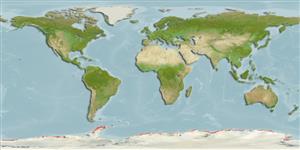Hydrozoa |
Leptothecata |
Sertulariidae
Environment: milieu / climate zone / depth range / distribution range
Ecology
Demersal; depth range 15 - 100 m (Ref. 7416). Polar
Antarctic: South Shetland and Antarctica.
Length at first maturity / Size / Weight / Age
Maturity: Lm ? range ? - ? cm Max length : 6.0 cm WD male/unsexed; (Ref. 7416)
Colonies consisting either of incipient stems or of a mass composed of numerous tangled stems and branches forming a mesh of up to 6 cm in diameter. Branching frequent, irregular and in several planes; sometimes alternate, but in two planes making an acute angle. Branches originating laterally at the hydrothecal base; plane formed by hydrothecae of lower-order branch perpendicular to that formed by hydrothecae of previous branch. Frequently, stem bent and giving rise to branches alternately arranged in two planes making an acute angle. Branches occasionally forming anastomosing stolons. Stem and branches divided into internodes; length of intenodes decreasing distally. Hydrothecae alternately arranged, curved abcaudally, with a distinct inflexion point where the adcauline wall becomes free. Hydrotheca adnate to internode for more than half of its adcauline wall. Free part of adcauline hydrothecal wall straight or slightly convex. Abcauline wall slightly concave. Hydrothecal aperture directed up- and outwards. Rim of hydrothecal aperture provided with three blunt cusps; the adcauline cusp slightly curved adcaudally at its distal extremity. Gonothecae oval, inserting at hydrothecal base. Gonothecal wall folded, forming a distinct keel descending in seven to ten turns. Gonotheca distally provided with a long, funnel-shaped neck bearing the gonothecal aperture and projecting far above cavity formed by the first turn of the keel.
Known at depths of 15 to 100 m and 80 to 634 m on muddy bottoms (Ref. 7416).
Life cycle and mating behavior
Maturity | Reproduction | Spawning | Eggs | Fecundity | Larvae
Fertile colonies were found from January to March, though in March only with immature gonothecae.
Peña Cantero, A.L., A. Svoboda and W. Vervoort 2002 Species of Stymplectoscyphus Marktanner-Turneretscher, 1980 (Cnidaria; Hydrozoa: Sertulariidae) from recent Antarctic expeditions with R.V. Polarsten, with the description of four new species. Journal of Natural History 36:1509-1568. (Ref. 7416)
IUCN Red List Status
(Ref. 130435: Version 2025-1)
CITES status (Ref. 108899)
Not Evaluated
Not Evaluated
Threat to humans
Harmless
Human uses
| FishSource |
Tools
More information
Trophic EcologyFood items (preys)
Diet composition
Food consumption
Predators
Population dynamicsGrowth
Max. ages / sizes
Length-weight rel.
Length-length rel.
Length-frequencies
Mass conversion
Abundance
Life cycleReproductionMaturityFecunditySpawningEggsEgg developmentLarvae PhysiologyOxygen consumption
Human RelatedStamps, coins, misc.
Internet sources
Estimates based on models
Preferred temperature
(Ref.
115969): -1.9 - -1.2, mean -1.5 (based on 45 cells).
Fishing Vulnerability
Low vulnerability (10 of 100).
